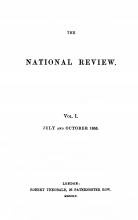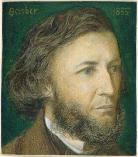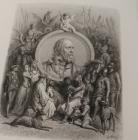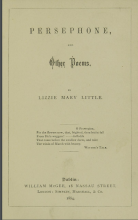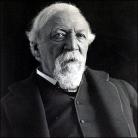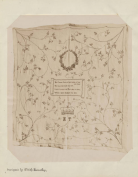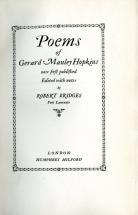Timeline: Victorian Poetry, Reforming Christ's Body
Created by Joshua King on Thu, 08/22/2019 - 17:38
Part of Group:
This timeline represents events related to your rare-item projects for this class.
Timeline
Chronological table
| Date | Event | Created by | Associated Places | |
|---|---|---|---|---|
| 1846 |
The People's Journal founded by John Saunders and William HowittThe People's Journal was a weekly periodical that published stories, poetry (including some by working class authors), book reviews, essays, and uplifting news stories. It reflected the hopes of some progressive literati that education and individual effort would eliminate the economic inequality of mid-nineteenth century England. To read a related blog post, click here: https://blogs.baylor.edu/19crs/2020/01/17/progressive-pragmatic-redemption-the-peoples-journal/. |
Samantha Kiser | ||
| Jul 1855 to Nov 1864 |
The National Review: A Nine Year RunThe National Review was a quarterly periodical started by Unitarian minister James Martineau. Besides Unitarian topics, the periodical ran articles on literature, politics, and social affairs, featuring essays from such influential figures as Matthew Arnold, Coventry Patmore, and David Brewster. The editors, R. H. Hutton and Walter Bagehot, attempted to reach a wide readership while keeping their Unitarian supporters happy. This balance proved difficult to support in the long run, and after nine years, most of their sponsors left to begin backing the Theological Review, a newer and more strictly Unitarian periodical. Several years before its demise, the journal published a review of Elizabeth Barrett Browning's Aurora Leigh that reflected the author's Unitarian sympathies. To read a related blog post, click here: https://blogs.baylor.edu/19crs/2020/01/17/reactions-to-aurora-leighs-christianity-in-contemporary-book-reviews/ |
Shannon McClernon | ||
| 17 Nov 1855 |
Publication of Robert Browning's Men and WomenOn November 17, 1855, Robert Browning’s Men and Women was published in two volumes by Chapman and Hall, a London publishing house. Although Men and Women garnered little critical or popular attention, it represents a significant development in Browning’s dramatic monologue form. This collection brings together the expressions of 50 “men and women,” including that of Fra Lippo Lippi, a fifteenth-century Italian painter. Many of the themes of artistic depiction explored in “Fra Lippo Lippi” would be revisited by Browning the poet in a later poetic hit, The Ring and the Book (1868). To read a related blog post, click here: https://blogs.baylor.edu/19crs/2020/01/15/blots-and-blanks-discussions-of-artistic-depiction-in-the-ring-and-the-book-and-fra-lippo-lippi/ |
Allison Scheidegger | ||
| The end of the month Spring 1866 |
The Death of John KebleOn the 29th of March, 1866, the notable churchman and poet John Keble dies, followed soon by his wife Charlotte on the 11th of May. This sparks an almost immediate reaction of reflection on his legacy as a writer and church leader across England. Numerous publications consider his life and work in the following years, many focusing on his most influential text: the collection of poems liturgically organized in The Christian Year. In the five years that followed Keble’s death, his name is celebrated with a major biography and a college at Oxford (pictured here) which would be dedicated to the teachings of the Church of England. He and his wife are burred at the All Saints Churchyard in Hursley. To read a related blog post, click here: https://blogs.baylor.edu/19crs/2020/01/15/keble-in-conversation-reception-and-use-of-kebles-language-in-the-letters-of-edward-and-elizabeth-dickinson-dowden/ |
Stewart Riley | ||
| 1868 |
Moxon Publishes Illustrated IdyllsIn 1868 Edward Moxon and Co. published an ambitious and ornate illustrated edition of Alfred, Lord Tennyson's Idylls of the King. The engravings were provided by Gustave Doré, who had recently illustrated John Milton's Paradise Lost and the Bible. Although the volume was assumed to be successful, its publication was characterized by tensions between Tennyson and James Bertrand Payne, the manager of Moxon and editor of the edition. To read a related blog post, click here: http://blogs.baylor.edu/19crs/2020/01/15/layers-of-interp…-king-in-context/ |
Andrew Hicks | ||
| Summer 1879 to Autumn 1879 |
Christina Rossetti's 'Seek and Find' PublishedIn late summer to early fall of 1879, the Society for Promoting Christian Knowledge published Christina Rossetti's Seek and Find: A Double Series of Short Studies on the Benedicite. Though this work was likely influenced by G.C. Child's Benedicite; or, Song of the three children published in 1866, Rossetti offers a unique commentary on the Benedicite through her devotional prose, one that exemplifies her own theological vision of creation. Seek and Find presents a two-fold reading of the Benedicite, through the lenses of "Creation" and "Redemption," in which Rossetti aims to edify readers in contemplating Christ in all of creation, for each created thing bears an inherent beauty resembling that of the divine. To read a related blog post, click here: http://blogs.baylor.edu/19crs/2020/01/15/contemplating-ch…is-seek-and-find/ |
Maggi Jones | ||
| 1884 |
Publication of Lizzie Mary Little's "Voices of the Age"Lizzie Mary Little's 1884 poem, included in the collection Persephone, and Other Poems , comments upon changing views of science, poetry, and truth in the Victorian era. In the poem, Little speaks through the voice of a Romantic Bard of Nature, a Disillusioned Modern Man, a Scientific Humanist, and a Christian. Published close to the end of the Victorian era, the poem draws, both directly and indirectly, from many significant events and literary works of the nineteenth century. For example, Little refers to the end of the Romantic age of poetry (around the 1830’s), and directly references the theory of evolution, which gained prominence with Darwin’s 1859 publication On the Origin of Species. She also alludes to numerous poems by contemporary poets, such as Matthew Arnold’s “Stanzas from the Grand Chartreuse” (1867), and Alfred Lord Tennyson’s In Memoriam A.H.H. (1850). By incorporating many important works of the preceding era, the poem functions as a fin de siècle retrospective of nineteenth century science and poetry. To read a related blog post, click here: http://blogs.baylor.edu/19crs/2020/01/15/victorian-voices…oices-of-the-age/ |
Kelly Collins | ||
| 13 Jul 1889 |
Robert Browning Responds to Edward Fitzgerald's Disgraceful Assault on Elizabeth Barrett BrowningDuring 1887 and into 1888, Robert Browning works on revising his collected works. He completes the first 10 of the planned 19 volumes. Among the first 10 volumes is his master work, The Ring and the Book. It is widely believed to be devoted to his wife, Elizabeth Barrett Browning, in the closing lines of the first and twelfth book, where he calls upon "lyric love." Early in July 1889, Browning sees the postumously collected letters and works of Edward Fitzgerald lying on a table while he is visiting a friend. He reads through them and finds Fitzgerald's letter to William Hepworth Thompson of Trinity College and the cruel remarks concerning Elizabeth Barrett Browning's recent death. In response, 28 years after Fitzgerald composed the letter and six years after his death, Browning angrily pens and has published the sonnet "To Edward Fitzgerald" in The Athenaeum no. 3220 on 13 July 1889. To read a related blog post, click here: http://blogs.baylor.edu/19crs/2020/01/15/robert-brownings…barrett-browning/ |
Ray Stockstad | ||
| 1892 |
Publication of Christina Rossetti's "The Face of the Deep: A Devotional Commentary on the Apocalypse"Rossetti's devotional commentary includes bits of poetry interspersed among a primarily prose text. The title page of Rossetti's Verses, published in 1893, includes the following note, "Reprinted from 'Called to be Saints,' 'Time Flies,' and 'The Face of the Deep.'" Most of the poems in the opening sonnet sequence of Verses, "Out of the Deep Have I Called Unto Thee," are from The Face of the Deep. Examining poems from Verses, such as “A Vain Shadow," in their original contexts in The Face of the Deep can open up new ways of reading them. The attached picture shows "A Vain Shadow" in its context in Rossetti's commentary. To read a related blog post, click here: http://blogs.baylor.edu/19crs/2020/01/15/creation-in-cont…face-of-the-deep/ |
Ryan Sinni | ||
| 12 Autumn 1892 |
Alfred Lord Tennyson's FuneralOn this day, Alfred Lord Tennyson was buried at Westminster Abbey in a service conducted by George Bradley, a personal friend. The attached image is a photograph of the funeral pall designed by Edith Rawnsley. Edith Rawnsley also wrote a hymn praising Tennyson which was included in a collection of sonnets and other items related to Tennyson's death (including the attached photograph) gathered (and largely composed) by her husband, Canon Hardwicke Rawnsley. To read a related blog post, click here: http://blogs.baylor.edu/19crs/2020/01/15/hymning-tennyson…onal-hagiography/ |
Caleb Little | ||
| 1918 |
Publication of 'The Poems of Gerard Manley Hopkins'In 1918, Poet Laureate Robert Bridges published the first extended collection of Gerard Manley Hopkins’s poetry—The Poems of Gerard Manley Hopkins. This edition is known for Bridges's somewhat harsh prefatory material, where he criticizes Hopkins’s strange poetic style and calls it superfluous. However, it is precisely through Hopkins’s superfluous or unnecessary style—represented by features like additional accents and intentional obscurity—that Hopkins disrupts the expectations of his readers and teaches them how to behold and appreciate the natural world around them. To read a related blog post, click here: http://blogs.baylor.edu/19crs/2020/01/15/injured-by-a-nat…nge-poetic-style/ |
Christina Lambert |

